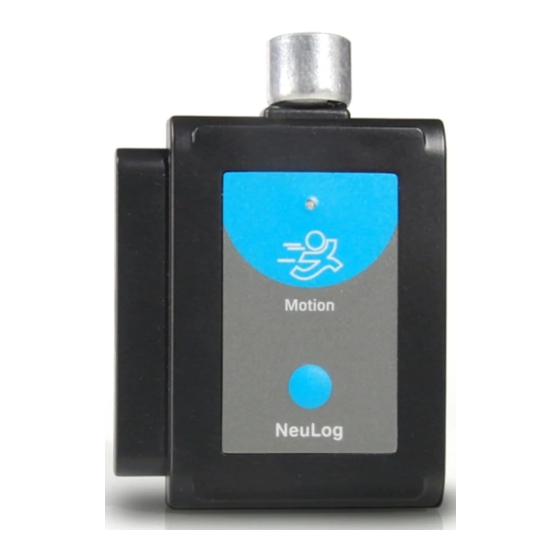
Advertisement
Quick Links
NeuLog motion logger sensor
NUL-213
The NeuLog motion sensor can be used for any science experiment or activity which
requires accurate distance, velocity, or acceleration readings such as in the fields of
Physics, Mechanics, Physiology, Biology, etc
The sensor comes pre-calibrated so you can start experimentation right out of the box
using any of the following guides.
The motion sensor uses an ultrasonic transducer to both transmit an ultrasonic wave,
and to measure its echo return. Objects in the range of 0.15 to 6 meters can
accurately be measured to give distance, velocity, and acceleration readings using
this method.
Just a few of the thousands of possible experiments that can be done with the NUL-
213 sensors are: gravity experiments, ball drops, momentum, impulse, conservation of
energy, kinetic vs. potential energy, and many more.
The motion sensor can collect data using the following units of measure:
Meters (m): The SI distance unit
Meters/second (m/s): The SI velocity unit which measures the distance
traveled over time.
2
2
Meters/second
(m/s
): The SI acceleration unit which measures the change
in velocity over time.
For best results:
The NUL-213 motion sensor has a working range between 0.15m and 6.0 meters,
results may be inconsistent outside of this range. Ultrasonic waves that are emitted
from the sensor and spread out in a cone pattern at about 15° around the point of
reference.
NEULOG MOTION LOGGER SENSOR GUIDE
If possible, attach the sensor to something stable to avoid movements which can
give skewed readings.
If you get poor readings, another object in the foreground or background that is
within the cone that may be reflecting the ultrasonic waves to add noise to the
experiment.
Use objects which are at least 10cm x 10cm when tracking specific targets.
For smaller targets we recommend starting the object closer to the sensor, for
larger objects we recommend starting farther away.
When testing in areas with many hard surfaces; the waves may bounce around
and create extra noise for the detector. This can cause irregular graphs. To
reduce the noise level try covering some of the surrounding surfaces with a soft
material to dampen sound such as cloth or foam.
When using the motion sensor to detect an individual's movements; trying
carrying the sensor instead of pointing the sensor at one self. For example to
measure a student's velocities have them walk or run with the sensor while
pointing it at the wall.
Make sure your motion sensor is not mounted near a computer, monitor, or
television.
Sometimes other sources of sound (such as fans, motors, etc can affect results).
Try various sample rates until the cleanest data is observed, slow rates may
provide better results for certain experiments.
Distance, velocity, and acceleration graphs:
During motion experiments it is often beneficial to show distance, velocity, and
acceleration all on the same graph. Using the NeuLog software it is very easy to plot
all three graphs at once:
Advertisement

Summary of Contents for NeuLog NUL-213
- Page 1 15° around the point of Distance, velocity, and acceleration graphs: reference. During motion experiments it is often beneficial to show distance, velocity, and acceleration all on the same graph. Using the NeuLog software it is very easy to plot all three graphs at once:...
- Page 2 Your motion sensor needs to be connected to a WIFI-201 module. The WIFI-201 USB-200 USB Module module will create a closed NeuLog wifi network which will stream the NeuLog data to A USB to mini USB cable (which comes with the USB-200) a device of your choosing.
- Page 3 Take your tablet or smart phone and go to the Wi-Fi settings and select the Off-line experiments NeuLog network which matches the WIFI module ID found on the back of (Off-line experiments are for when you do not have a sensor connected directly to a the WIFI-201 device.
- Page 4 Distance Velocity Acceleration in each plastic NeuLog body. This technology allows the sensor to collect and then Range and store the digital data in the correct scientific units ( F, Lux, %, ppm, for example).
- Page 5 NEULOG MOTION LOGGER SENSOR GUIDE Warranty: We promise to deliver our sensor free of defects in materials and workmanship for a period of 3 years from the date of purchase. Our warranty does not cover damage of the product caused by improper use, abuse, or incorrect storage. Sensors with a shelf life such as ion selective proves have a warranty of 1 year.













Need help?
Do you have a question about the NUL-213 and is the answer not in the manual?
Questions and answers